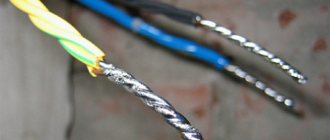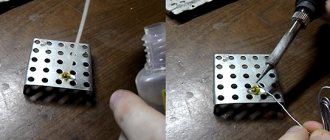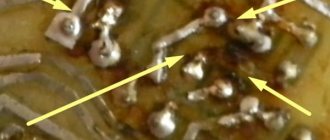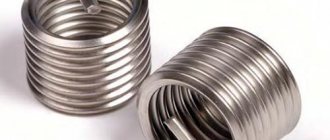Basic information about the tinning process
Tinning is divided into initial, carried out on a new or long-stored soldering iron, and working, performed immediately before soldering.
How to tin a soldering iron tip? First, the tip is mechanically cleaned of scale, oxide film, slag and other contaminants, then a thin layer of molten solder, most often tin-based, is applied to the prepared surface.
For mechanical cleaning the following are used:
- abrasive stone;
- sandpaper;
- another soldering iron.
Cleaning a soldering iron with a non-burn tip
For inexperienced soldering workers, craftsmen recommend starting with a file. As the solder strengthens his skills, he selects the most convenient stripping methods for himself.
Why tin and sharpen
Tinning the tip before soldering significantly simplifies all operations with a soldering iron, which consist of transferring molten solder to the contact area.
This procedure can only be avoided if the purchased soldering device has a tip covered with a protective film of silver. The silver-based coating holds solder well without compromising the thermal conductivity of the copper base.
However, products with such a coating cost a lot of money; In addition, the silver film comes off over time and exposes the copper base (they say that it dissolves in the solder). So in this case, after some time, the sting will have to be tinned, one way or another.
It is necessary to sharpen the tip with a file not only before tinning, but also in cases where it is necessary to give the tip a shape convenient for work.
Some users prefer the tip to be sharpened to a cone. Others try to sharpen its side parts in such a way as to obtain a flat, pointed shape.
Preparation and Maintenance
The more intense the work, the sooner the soldering iron tip burns out and becomes overgrown with scale scales.
During prolonged heating to high temperatures, the copper from which the tip is made partially transforms into molten tin, and partially abrades on the soldered surfaces and contacts. Physical and chemical erosion of the substance occurs. In addition, under the influence of heat, an oxidative reaction of copper with atmospheric oxygen occurs. On models that allow you to regulate the temperature, it is recommended to reduce it when there are breaks in soldering, or simply turn off the soldering iron during this time.
Sequence of operations to remove scale:
- Carefully remove the sting.
- Clean off the scale layer with fine-grained abrasive paper.
- Apply a graphite protective layer to the tip by rubbing it with a pencil lead. This will slow down the reappearance of the scale layer.
- Lightly tap the body of the electric heater and turn it to remove scale from the recess for the copper rod.
- Insert the tip back into the mount.
To ensure electrical safety, each time before starting work, you should inspect the insulation of the network cable for the absence of mechanical damage and melting.
From time to time it is also useful to measure the insulation resistance value. The measurement is taken between the plug contacts and the tip. The value must be greater than 10 mOhm.
Preparing a new soldering iron
Preparing a soldering iron for work involves calcining its executive part (tip) to a state in which it can fully perform its functions.
The fact is that any soldering tool just brought from the store has traces of copper oxides on the tip (they are formed after prolonged contact with air). Naturally, this coating worsens contact with working compounds (solder and flux).
Preparing the tool for work means eliminating all interference with good adhesion of the tip surface to the solder.
To achieve this, the following steps must be taken:
- First, the tip should be thoroughly calcined until the metal acquires a reddish-orange tint. From this moment it will burn, that is, the process of thermal burning of oxide residues begins, accompanied by a characteristic pungent odor.
- Secondly, after a certain time, when carbon deposits characteristic of copper appear on the surface of the tip, you should scrape it off with any sharp metal object.
- Thirdly, the soldering iron tip, cleared of carbon deposits, must undergo another operation called tinning. In order to tin high-quality tips of any type, you should learn to distinguish between the options for their execution.
Features of the sting
The sting is the main (and only) working part of the device. It is heated by an electric heater and heats the solder, rosin (or other flux) and the parts to be soldered. During operation, an invisible oxide film forms on it, reducing the wettability of the material. Visually it looks like this: tin or rosin does not spread evenly over the entire area, but collects in a drop and flows down.
The size and geometry of the working body are chosen so that they correspond to the operations performed. So, when soldering parts of large sizes and thickness, choose a powerful soldering iron with a thick tip. To install microcircuit legs, on the contrary, a particularly low-power device is required, with a thin tip and good grounding, so as not to damage sensitive components due to static charge or overheating.
Soldering microcircuits
A universal soldering iron is sharpened with a spatula. Thin parts are soldered with the narrow side, and more massive ones with the plane of the blade.
How to cheat? What is it for
In this way, materials are protected from oxidation, the action of alkalis and acids. This process involves coating the metal that needs protection with a small layer of a material that is better able to resist oxidation.
Most often, tin is used for such purposes, which is practically unaffected by moisture and air and does not react at all to the effects of fats and vegetable acids.
The process of coating the protected material with tin was called tinning, and the tin layer was called half-doing.
- It is important to tin with high quality, ultimately obtaining a dense layer of tin that will provide the necessary protection for a certain surface.
- After tinning operations, electrical soldering is performed, which includes cleaning all parts, applying flux and, directly, tinning.
- First, those surfaces that need to be soldered are folded, flux is applied to the soldering site, then this place is heated well, then solder is applied.
- When the solder begins to spread, you need to remove the heat and wait until it completely crystallizes and cools down.
- If there are flux residues, the soldering area needs to be thoroughly washed.
Radio amateurs tinning flat surfaces, most often printed circuit boards. Here this process is significantly simplified - you can tin several elements at once and then “protect” each of them from influences.
A board with tinned tracks is a convenient component for further assembly, and it does not matter how long it lies idle. Tinned tracks hide small defects and increase their current load.
But tinning with such a soldering iron does not bring much pleasure due to the appearance of careless smears, needles, and an uneven layer of semi-solder.
- To tin small iron parts, you need to “send” them into the melt by preparing a small bath of “Rose” alloy, heated on a regular stove at a temperature no higher than 120-140°C.
- Tinning begins by gripping the board with long-handled pliers. Then they are pickled with 5% hydrochloric acid and washed well in running water for a couple of seconds. After this, you need to immerse the board in the melt itself for 2 seconds.
- For such work, installation of a hood and thermostat is required. Of course, there is no need to install such equipment at home. Here, upgrading the process can occur by purchasing a more powerful soldering iron and making a simple tool from scrap materials.
How to tin a soldering iron with a copper tip
Tinning a soldering iron is a simple job and usually does not cause any difficulties. If the surface of the rod is well prepared and cleaned, then both tin-lead and silver solders fit well on it.
Soldering iron with copper tip
It is necessary to clean the surface of the rod to the condition of a new part. First you need to work with coarse sandpaper, level the surface and give it the required shape. If it is technically possible, it is a good idea to polish the surface - this way it will oxidize more slowly.
There is another technique - binding. To do this, the tip should be pulled out of the heater and, like a blacksmith, forged with a hammer on an anvil (or a massive vice). A surface compacted in this way will also oxidize much more slowly.
After machining, it’s time to actually tin the tip. Experienced shareholders recommend various methods:
- Place a few pieces of solder in the rosin can. Heat the soldering iron and dip the stripped tip into it. Rosin melt will act as a flux additive and will prevent the metal from becoming coated with an oxide layer. Instead, it will be coated with a layer of tin. Next, you need to take a square of coarse natural cloth and wipe the freshly tinned tip. In this case, the tin will rub over the surface and stick to it perfectly. The disadvantage of this method is a lot of smoke and a strong smell.
- The next method of tinning the tip produces less smoke, but requires more labor. A piece of coarse natural cloth should be laid out on a smooth board, sprinkled with crushed rosin or a whole piece should be placed on it. Dip the stripped tip into rosin and rub the surface with a solder rod. This operation will have to be repeated several times, and then rub the working surface on rosin cloth.
A soldering iron with a copper tip must be tinned each time before soldering and always after storage without use.
Special means
As special agents, it is allowed to use active organic mixtures (fluxes), as well as pastes of a special composition. The use of fluxes makes it possible to increase the efficiency of wetting the tip material with solder and, accordingly, improve tinning performance.
Domestic manufacturers offer several types of flux, which are available for public sale in hermetically sealed plastic packaging. When working with a composition consisting of ethyl alcohol with added catalytic additives, the temperature in the processing area does not exceed 300 degrees. This indicator satisfies the requirements for choosing the correct tinning mode for most materials used for the manufacture of tips.
The procedure for using active paste additives differs only in the way they are applied to the surfaces being treated.
How to tin a soldering iron tip while working
If you carefully clean and tin the tip, then after half an hour of work, or even earlier, tin will no longer accumulate on it. The copper slowly began to burn, and slag residues accumulated on it. There is no point in pressing the soldering iron harder, stop for tinning. There are a number of techniques for tinning the tip.
Using a wooden block
A rough wooden block (spruce or pine, they contain natural resin, similar in composition to rosin). Pour a small amount of flux composition onto the block and put a small piece of solder. If you notice dross, you can strip and tin the tip again with little interruption.
In a metal sponge
This quick tin tip method will require some preparation. Place a household wire dish sponge in a metal cup. The lower part of the sponge should be coated with a thick flux, such as soldering lard. By slightly immersing the tip in the sponge, it can be cleaned of slag and scale. And if you pick up a drop of tin and immerse it deeper into the sponge, it will turn out to be tinned.
Tinning the tip with a metal sponge
This method can be used to clean and tin both a classic copper tip and modern ones made of nickel or ceramic.
In rosin
This traditional method of tinning requires a certain amount of dexterity and speed of movement. Copper oxidizes very quickly, and you may not have time to bring the tip from the point of mechanical cleaning to the container with flux. Therefore, they clean directly under flux, placing a file under the tip. You need to rub the tip over the file until the flux melts, after which you can tin it by holding a tin rod.
Tin the classic way
Another traditional method of tinning involves the use of refractory solder. The refractoriness of the solder allows it to evaporate more slowly from the surface of a tinned soldering iron and will remain on the copper longer. It will require:
- file with frequent notches;
- rough board made of coniferous wood;
- rosin;
- a piece of refractory solder.
The sequence of actions is as follows:
- put solder on the board;
- clean one side;
- dip deeply into rosin;
- quickly clean it on a board, running it over the solder;
- repeat for the second side.
Next, you should tin the round surface between the edges.
Preparing the wire for soldering
To solder copper wires, they must be tinned in the same way as the soldering iron itself. To work, you need to warm up the tip to operating temperature. The tip is dipped into flux or rosin, then onto solder, after which the wire is pressed tightly. All this must be done quickly so that the rosin does not have time to evaporate. This work will have to be repeated several times. As a result of the procedure, a high-quality layer of solder should be obtained on the surface.
The process of tinning oxidized parts differs in time. It is recommended to first remove oxides using an abrasive material. In very difficult cases, tinning acid, chemical compound or solder paste will be required. Solder wire is sometimes used for soldering. In this case, you need to dip the rod in rosin, then apply it to the surface that needs to be tinned, and put solder between them. Rub the edge of the solder with the tip of the sting.
https://www.parnikiteplicy.ru/www.youtube.com/watch?v=Jqkivy-uRpk
Some wires may be protected with enamel. To remove it, you can treat the wire with acetylsalicylic acid, that is, regular aspirin. The tablet is placed in place and pressed with a soldering iron. After some time, the tablet melts and the acid attacks the varnish and is destroyed. After such a simple procedure, tinning the wire is not difficult.
How to tin a modern soldering iron tip
According to manufacturers' declarations, tips made of ceramic or nickel do not require tin-plating. In real life, they are also susceptible to the formation of soot and scale. It will not be possible to tin such a soldering iron in the usual way. You will need:
- cotton rags;
- jar of rosin;
- solder rod.
Soldering iron with ceramic tip
You should wipe the tip on a rag and immediately immerse it in rosin. Along the tip you need to immerse a solder rod in boiling rosin. It will melt and stick to work surfaces.
Metal sponge
There are often soldering irons on sale with the working part coated with special protective compounds made of stainless steel (this coating is called “non-burnable”). It has a thickness of several microns, so sharpening and tinning the tip is completely unacceptable due to the possibility of destruction of the coating due to strong friction.
In this case, the simplest method of dry tinning and cleaning the tip is used, using a steel sponge.
Its spring cells ensure good grinding of the tip and allow you to quickly tin its working surfaces. This method can be used when preparing soldering irons equipped with ceramic and nickel tips, as well as those with a very thin tip.
The special steel mesh can be replaced with a regular kitchen sponge. To clean the sponge itself, simply tap the mesh on the table, after which all the remaining solder will fall out at the bottom of it. The cost of this cleaning accessory does not exceed fifty rubles, so you can buy it immediately with a reserve.
With any of the proposed options, damage to the soldering iron due to strong pressure is practically excluded.
Tinning methods
There are several ways to clean work surfaces before tinning:
- Using abrasive materials. Needle file, file, whetstone, sandpaper.
- Using forging. It is recommended to remove the tip before processing it.
- Using another soldering iron. The tips rub against each other.
After stripping, you should immediately, without waiting for the oxide layer to recover, immerse the tip in a container with rosin. A rod of solder is also immersed there, melting it and allowing it to spread over the surface of the rod. This operation should be repeated several times to ensure that the working surfaces are completely covered with solder.
Next, rub the tip on a pine or spruce board to ensure even distribution of the solder.
Tinning with rosin
The tip must be carefully inspected. If there are areas not covered with solder, the operation should be repeated until a dewy continuous layer is obtained.
You won't be able to tin it once and for all. Tinning needs to be repeated periodically.
File and sandpaper
The classic way to prepare and tin a soldering iron tip before starting to work with it is to process it with a file (sandpaper) together with the use of high-quality rosin.
When preparing a tip using this method, you first need to sharpen one of the edges of the tip with a finely cut file, after which it is immersed in rosin and rubbed over a wooden board with molten solder.
Note that this procedure must be repeated several times. Upon completion of tinning, one facet should be sharpened and tinned in the same way.
To tinning a copper tip sharpened “to a cone”, it is first sanded with sandpaper along the entire working circumference, after which it is tinned with a rotational movement on a wooden lining with molten solder.
Why does the soldering iron turn black?
Overheating of the tip. This is one of the most common and serious reasons. In this case, you can notice that the tool was previously heated to a very high temperature, so that its color changed even during heating. As a rule, this is severe redness, after which the person turns off the soldering iron and begins the soldering process.
Interesting materials:
How to delete a video in contact that is not deleted? How to delete a video in telegram? How to delete a virtual machine in vSphere Client? How to delete a VMware Workstation virtual machine? How to delete a virtual disk on a computer? How to remove a virtual drive created by Ultraiso? How to delete a VHD virtual hard disk? How to remove a virus shortcut from a flash drive? How to remove a virus from chrome? How to remove a redirect virus to another site?
Tinning at home
Almost every household breakdown can be easily fixed using a regular soldering iron. He is capable of breaking wires, disconnecting contacts, etc.
Websites are full of instructions on choosing the right tool, selecting flux and solder, but not all talk about the correct tinning of a soldering iron.
And poor-quality tinning will lead to the fact that your efforts will be in vain, and the contacts in the soldering iron will be unreliable.











